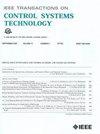Predictive Control for Autonomous Driving With Uncertain, Multimodal Predictions
IF 3.9
2区 计算机科学
Q1 AUTOMATION & CONTROL SYSTEMS
引用次数: 0
Abstract
We propose a stochastic model predictive control (SMPC) formulation for path planning with autonomous vehicles in scenarios involving multiple agents with multimodal predictions. The multimodal predictions capture the uncertainty of urban driving in distinct modes/maneuvers (e.g., yield and keep speed) and driving trajectories (e.g., speed and turning radius), which are incorporated for multimodal collision avoidance chance constraints for path planning. In the presence of multimodal uncertainties, it is challenging to reliably compute feasible path planning solutions at real-time frequencies (不确定、多模式预测下的自动驾驶预测控制
我们提出了一种随机模型预测控制(SMPC)公式,用于自动驾驶汽车在涉及多个智能体和多模式预测的场景下的路径规划。多模式预测捕获了不同模式/机动(例如,退让和保持速度)和驾驶轨迹(例如,速度和转弯半径)下城市驾驶的不确定性,这些不确定性被纳入路径规划的多模式碰撞避免机会约束。在存在多模态不确定性的情况下,如何可靠地计算实时频率下可行的路径规划解是一个挑战(${\geq }10~\mathrm {Hz}$)。我们的主要技术贡献是一个凸SMPC公式,它同时1)优化了参数化反馈策略,2)为每种预测模式分配风险水平。反馈策略和风险分配的使用增强了SMPC公式对具有大不确定性的多模态预测的可行性和性能。我们通过仿真和全尺寸车辆与虚拟车辆在闭环中相互作用的道路实验来评估我们的方法。我们考虑了不同的、多模式的驾驶场景:1)通过交通灯(TL)和快速尾随的代理;2)在交通路口无保护左转;3)在多个代理存在的情况下换道。对于所有这些场景,我们的方法可靠地计算实时频率下路径规划问题的多模态解决方案。
本文章由计算机程序翻译,如有差异,请以英文原文为准。
求助全文
约1分钟内获得全文
求助全文
来源期刊

IEEE Transactions on Control Systems Technology
工程技术-工程:电子与电气
CiteScore
10.70
自引率
2.10%
发文量
218
审稿时长
6.7 months
期刊介绍:
The IEEE Transactions on Control Systems Technology publishes high quality technical papers on technological advances in control engineering. The word technology is from the Greek technologia. The modern meaning is a scientific method to achieve a practical purpose. Control Systems Technology includes all aspects of control engineering needed to implement practical control systems, from analysis and design, through simulation and hardware. A primary purpose of the IEEE Transactions on Control Systems Technology is to have an archival publication which will bridge the gap between theory and practice. Papers are published in the IEEE Transactions on Control System Technology which disclose significant new knowledge, exploratory developments, or practical applications in all aspects of technology needed to implement control systems, from analysis and design through simulation, and hardware.
 求助内容:
求助内容: 应助结果提醒方式:
应助结果提醒方式:


